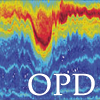
|
Aurelie Moulin Senior Oceanographer amoulin@apl.washington.edu |
Department Affiliation
 |
Ocean Physics |
Education
B.S. Oceanography - Marine Environmental Studies, Florida Institute of Technology, 2003
M.S. Physical Oceanography, Florida Institute of Technology, 2005
Ph.D. Oceanography, Oregon State University, 2016
Projects
|
Sampling QUantitative Internal-wave Distributions — SQUID Our goals are to understand the generation, propagation, and dissipation mechanisms for oceanic internal gravity waves to enable seamless, skillful modeling & forecasts of these internal waves between the deep ocean and the shore. |
More Info |
26 Feb 2024
|
|||||||
|
The SQUID team will provide a globally distributed observing program for shear, energy flux, and mixing by internal waves. We will use profiling floats — measuring temperature, salinity, velocity, and turbulence — that will yield new insights into internal wave regimes and parameterizations, and that will provide direct and derived data products tailored for use by modeling groups for comparison and validation. |
|||||||||
|
Publications |
2000-present and while at APL-UW |
Turbulent diapycnal fluxes as a pilot Essential Ocean Variable Le Boyer, A., and 16 others including A.J. Moulin, "Turbulent diapycnal fluxes as a pilot Essential Ocean Variable," Front. Mar. Sci., 10, doi:10.3389/fmars.2023.1241023, 2023. |
More Info |
28 Nov 2023 |
|||||||
|
We contend that ocean turbulent fluxes should be included in the list of Essential Ocean Variables (EOVs) created by the Global Ocean Observing System. This list aims to identify variables that are essential to observe to inform policy and maintain a healthy and resilient ocean. Diapycnal turbulent fluxes quantify the rates of exchange of tracers (such as temperature, salinity, density or nutrients, all of which are already EOVs) across a density layer. Measuring them is necessary to close the tracer concentration budgets of these quantities. Measuring turbulent fluxes of buoyancy (Jb), heat (Jq), salinity (JS) or any other tracer requires either synchronous microscale (a few centimeters) measurements of both the vector velocity and the scalar (e.g., temperature) to produce time series of the highly correlated perturbations of the two variables, or microscale measurements of turbulent dissipation rates of kinetic energy (ε) and of thermal/salinity/tracer variance (χ), from which fluxes can be derived. Unlike isopycnal turbulent fluxes, which are dominated by the mesoscale (tens of kilometers), microscale diapycnal fluxes cannot be derived as the product of existing EOVs, but rather require observations at the appropriate scales. The instrumentation, standardization of measurement practices, and data coordination of turbulence observations have advanced greatly in the past decade and are becoming increasingly robust. With more routine measurements, we can begin to unravel the relationships between physical mixing processes and ecosystem health. In addition to laying out the scientific relevance of the turbulent diapycnal fluxes, this review also compiles the current developments steering the community toward such routine measurements, strengthening the case for registering the turbulent diapycnal fluxes as an pilot Essential Ocean Variable. |
|||||||||
Flippin' χSOLO, an upper-ocean autonomous turbulence-profiling float Moum, J.N., and 11 others including A.J. Moulin, "Flippin' χSOLO, an upper-ocean autonomous turbulence-profiling float," J. Atmos. Ocean. Technol., 40, 629-644, doi:10.1175/JTECH-D-22-0067.1, 2023. |
More Info |
1 May 2023 |
|||||||
|
A new autonomous turbulence profiling float has been designed, built, and tested in field trials off Oregon. Flippin' χSOLO (FχS) employs a SOLO-II buoyancy engine that not only changes but also shifts ballast to move the center of mass to positions on either side of the center of buoyancy, thus causing FχS to flip. FχS is outfitted with a full suite of turbulence sensors — two shear probes, two fast thermistors, and pitot tube, as well as a pressure sensor and three-axis linear accelerometers. FχS descends and ascends with turbulence sensors leading, thereby permitting measurement through the sea surface. The turbulence sensors are housed antipodal from communication antennas so as to eliminate flow disturbance. By flipping at the sea surface, antennas are exposed for communications. The mission of FχS is to provide intensive profiling measurements of the upper ocean from 240 m and through the sea surface, particularly during periods of extreme surface forcing. While surfaced, accelerometers provide estimates of wave height spectra and significant wave height. From 3.5 day field trials, here we evaluate (i) the statistics from two FχS units and our established shipboard profiler, Chameleon, and (ii) FχS-based wave statistics by comparison to a nearby NOAA wave buoy. |
|||||||||
Freshwater lens fronts propagating as buoyant gravity currents in the equatorial Indian Ocean Moulin, A.J., J.N. Moum, E.L. Shroyer, and M. Hoecker-Martinez, "Freshwater lens fronts propagating as buoyant gravity currents in the equatorial Indian Ocean," J. Geophys. Res., 126, doi:10.1029/2021JC017186, 2021. |
More Info |
1 Aug 2021 |
|||||||
|
Freshwater lenses (FWLs) deposited by rain exhibit local anomalies in surface salinity and temperature. The resulting patchiness in near-surface density and sea surface temperature influence upper ocean dynamics and air-sea fluxes of heat. Understanding lens formation and evolution has been a focus of recent observational and modeling efforts. The work presented here integrates near-surface ocean and atmosphere time series with remote sensing of sea surface disturbances (X-band radar) to describe properties and kinematics of FWLs in the equatorial Indian Ocean. Twenty-eight FWLs were observed with diverse temperature-salinity properties and structure. Fresh salinity anomalies were as large as –1.35 psu at 3 m depth. Associated temperature anomalies ranged from –0.80 to +0.59°C. Ship-based radar imagery allowed quantification of propagation speeds of 10 FWL fronts. In the reference frame of the moving fluid, the observed speeds are consistent with the linear long wave speed. These results offer a novel perspective on the evolution of FWLs as gravity currents whose dynamics need to be properly accounted for to assess lens longevity, including persistence of salinity and temperature anomalies, as well as influences on air-sea interaction. |
|||||||||




